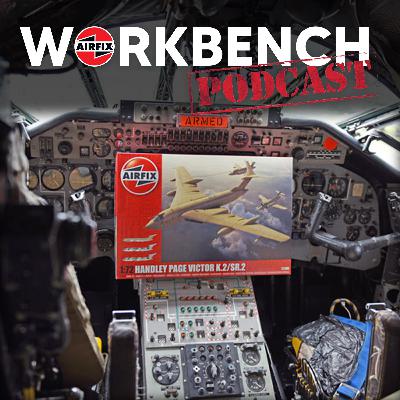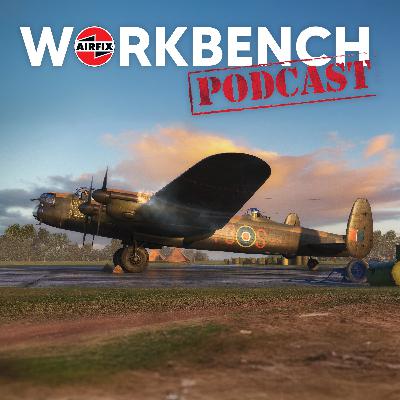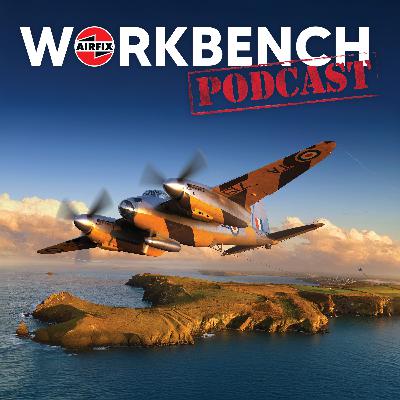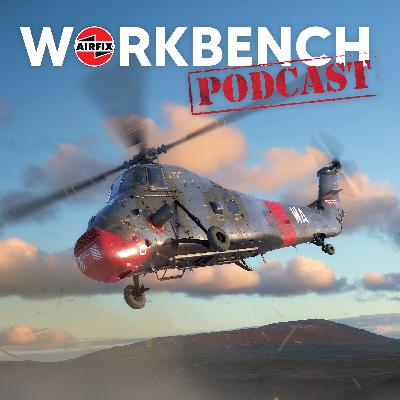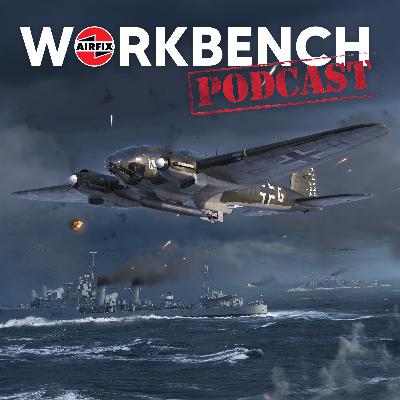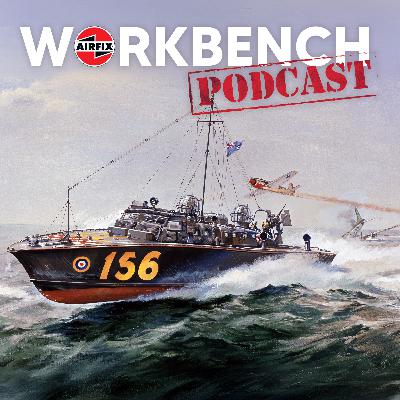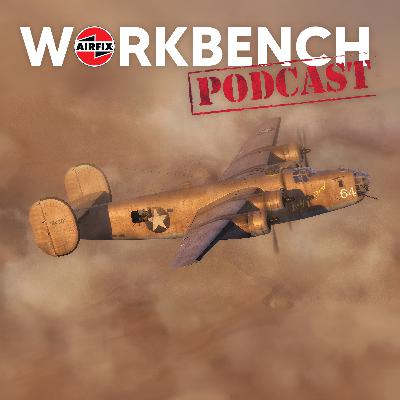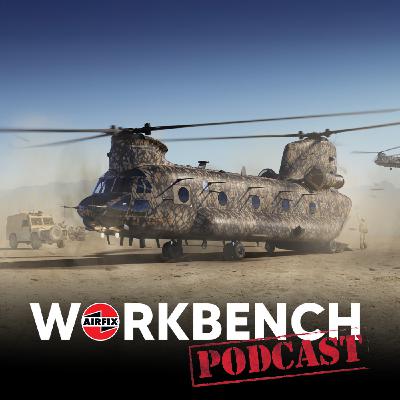Discover Airfix
Airfix

Airfix
Author: Airfix
Subscribed: 9Played: 118Subscribe
Share
© Hornby Hobbies Ltd 2025
Description
From the world of Airfix, dive into “Workbench”, the audio companion to Airfix’s beloved Workbench blog. Each episode brings the workshop to your ears, with a deep dive into everything from exclusive model reveals and technique spotlights to candid chats with the creators behind the builds.
- 🛠️ Exclusive Insights – Hear firsthand from Airfix designers and developers about the process behind your favourite kits,
- ✈️ Model Spotlight – Explore the story of each release, whether it’s a revived classic like the Blenheim or the latest Avro Anson kit
- 🎧 Community Chats – Join conversations akin to Sprue Talk, offering deeper insight into the wider modelling scene!
Whether you're tweaking paint layers or planning your next diorama, “Workbench" delivers expert guidance, creative inspiration, and the stories that bring scale modelling to life—anytime, anywhere!
25 Episodes
Reverse
Welcome to this latest edition of our Workbench blog and all the news, updates, and modelling exclusives from the fascinating world of Airfix.Our subject for this latest edition of Workbench is the heavily requested re-introduction of an incredibly popular kit, one which has to be regarded as one of the most impressive to have ever graced the Airfix range. The futuristic looking Handley Page Victor was the final aircraft of Britain’s trilogy of nuclear capable V-Bombers of the Cold War era, and arguably the one which was both the most advanced and the most versatile of the three. The aircraft was designed to wield incredible destructive power, but to ensure peace by the threat of the devastation it could bring, something of a dichotomy in terms, but one which helped to preserve an uneasy peace at one of the most volatile periods in world/European history.A kit which was originally released to such widespread modeller acclaim back in 2016, and again in this particular release format two years later, it has become increasingly difficult to get your hands on one of these stunning kits over recent months, so we decided that we had to do something about that situation, hence this release return. In addition to looking at why the Victor makes for such an impressive modelling project, we will be looking at the details behind the three scheme/decal options included with this kit, will have a selection of images detailing how our latest exclusive collector coin release will delight those ordering via the Airfix website, and see why the aircraft linked to the lead scheme option has just benefited from a rather radical new application of paint.We’re very much in the presence of one of Britain’s Cold War jet powered peacekeepers in this latest edition of Workbench.
Welcome to this latest edition of our Workbench blog and all the news, updates, and modelling exclusives from the fascinating world of Airfix.Well, what a spectacular weekend that turned out to be. With the latest instalment of the Scale ModelWorld phenomenon now done and dusted, we can confidently confirm that this modelling hobby we all enjoy so much, and the army of enthusiasts who consider themselves amongst its ranks, are both in a very good place right now, with the future of the hobby looking as bright as it’s ever been. As we reflect on a busy, but extremely enjoyable weekend, and allow our voices a little recovery time, we will be spending this latest edition of Workbench covering some of the activities team members were involved with over the weekend, in an attempt to share some of the atmosphere of what was a thoroughly enjoyable event once again.With a selection of exclusive images taken by members of the Airfix team over the weekend to illustrate the points under discussion, you can look forward to seeing the Airfix stand in all its glory, a quintuple of built Messerschmitt Bf 109 Gustav debutantes, competition winners entries and a fantastically imaginative Display of the Day/Show winner, along with the impressive people behind them all.As we try to keep the Scale ModelWorld ‘highs’ going for just a few days more, please join us as we review our show experiences at SMW 2025 in this latest edition of Workbench.
Welcome to this latest edition of our Workbench blog and all the news, updates, and modelling exclusives from the fascinating world of Airfix.You will have noticed that we have a slightly later publication timing for this latest edition of our Workbench blog this week, but for very good reason. By now, the Airfix events team will be hard at work setting up our display stand at the latest Scale ModelWorld show, and amongst our layout of impressive modelling riches, we have exciting news to share. As of 10am this morning, we were proud to announce our latest new tooling addition to the Airfix range, and it’s BIG news!It what has now become something of an Airfix tradition at Telford, the SMW show has regularly seen the team announcing new tooling projects as part of our attendance, with visitors to the International Centre over the weekend being the first to view the new kit in the plastic, whilst also having the opportunity to discuss this and all matters Airfix with the team in attendance. This latest release is something very special indeed, and if some like to challenge us about our fascination for producing kit tributes to the incredible Supermarine Spitfire, we have something very different for you this time around, in the shape of the Spitfire’s aviation arch nemesis, the Messerschmitt Bf 109. A spectacular new design in 1/24th scale, our new kit is a stunning representation of the G-5/G-6 variant of the Bf 109, the most heavily produced of more than 34,000 aircraft manufactured, and one which struggled to stem the tide of Allied air forces until the end of the Second World War.By way of an introduction to the new kit, we will be bringing you the details behind why the Messerschmitt Bf 109 ‘Gustav’ makes for such an appealing modelling subject, and will have a selection of exclusive imagery to help us do that, from new box artwork and built model images, to details behind each of the FIVE scheme options included with the first release of this new kit.The exclusive reveal of our new large scale tribute to one of the most significant fighting aeroplanes in the history of warfare is our headline subject for this week’s edition of Workbench.
Our blog title for this week was intentionally selected to possess a little more intrigue than usual, as we want to do something a little different with this latest edition. As far as we know, there’s never actually been an ‘Avro Week’ commemoration event, and certainly never here on the Workbench blog, but as we find ourselves on the cusp of the scale modelling world’s annual ‘gathering’ at Telford’s International Centre, we wanted to take a little break from featuring new tooling projects and secret additions to the current Airfix range. Instead, we wanted to place the blog spotlight on a selection of (relatively) recent model kit releases, all of which are currently in stock and available for modelling project duty right now. Interestingly, the three kits we have selected chart 20 years of aircraft design development at one of the most famous company’s in British aviation history, a name which became synonymous with powerful bomber types, but can trace its origins back to the early years of the 20th century. We will be seeing how 20 years can seem like a lifetime in the world of aviation, and whilst all three aircraft were groundbreaking in their own right at the time of their maiden flights, how they could hardly be more different from each other, when it came to both their appearance, and their capabilities. You will probably be able to guess which aircraft types we’re going to be featuring, but you can be absolutely certain that the Airfix range has beautifully crafted scale kit representations of each one, albethey in different scales, to allow our model display cabinets to feature our own appealing tributes to each one of them. When it comes to Avro aircraft types, the current Airfix range certainly helps scale Avro aviators to gain their hobby wings. As we push the virtual hangar doors back on this latest edition of Workbench, which of this trio of Avro classics will be making its way to the blog taxiway first?
Welcome to this latest edition of our Workbench blog and all the news, updates, and modelling exclusives from the fascinating world of Airfix. The one thing you have always been able to rely on Airfix to provide the modelling world with is an impressive selection of classic scale aircraft model kits across several different scales, something which helped inspire a great many young people on their career journeys to become engineers, pilots, or to simply continue enjoying this great hobby of ours. In our previous edition, we unveiled our latest ‘secret’ scale tribute to a later variant incarnation of one of the finest aircraft of the Second World War, and we’re returning to similar subject matter for this latest update, albeit in a larger scale. Regarded as arguably the most famous aircraft in the history of flight, but unquestionably the highest profile design to come from the British aviation industry, the Supermarine Spitfire served throughout the Second World War and beyond, with ever more examples undergoing restoration to airworthy condition, such is the enduring fascination with this aircraft. Our new kit subject for this latest edition really is something special, only the second stand alone kit release from this particular tooling, and a release which charts the post war career of a true stalwart of the historic aviation scene here in the UK. This kit presents the same aircraft in three different scheme guises spanning almost 70 years of flying.
As we currently find ourselves on the cusp of actual modelling season, with the longer nights providing us with an excuse to spend much more time at our workstations, can you think of a better way of celebrating this than by announcing our latest 'secret' model release? On Wednesday this week, we announced details of just the third releases from our popular 1/72nd scale de Havilland Mosquito tooling, as the previously unannounced additions to the current range just keep on coming. This new release announcement includes an additional frame of parts which allow several new Mosquito variant/ordnance options to be considered by the modeller, and in this latest edition of Workbench, we will be bringing you all the details you might need from this latest addition to the range. In a robust review, we have insights and development imagery direct from the kit designer’s computer, an impressive selection of built model images, and details behind the THREE new scheme options included with what’s sure to be a welcome addition to the range. We’re spending time with the ‘Wooden Wonder’ in this latest edition of Workbench, or at least our scale plastic kit tribute to it.
Welcome to this latest edition of our Workbench blog and all the news, updates, and modelling exclusives from the fascinating world of Airfix.With almost 400 Workbench blogs now successfully under our belts, we’re never afraid to try something just that little bit different when putting one together, with this current edition being something of a point in case. When announcing the latest kit additions to the current Airfix range, we sometimes unearth something very special, be that new information revealed in support of an included scheme option, or new box artwork which triggers fond memories for a former British serviceman. That’s exactly what happened when former member of the Royal Artillery Alister Constantine first saw the new box artwork for the second release from our Ferret Scout Car tooling, because it was the exact same vehicle that he operated throughout his service during the Gulf War.Kindly, Alister dropped our marketing team a line to inform us of the close link he had with our artwork, which was the start of a fascinating period for members of the Airfix team, particularly our lead videographer Nathan. He was fortunate enough to meet Alister, where they discussed all things Ferret, and this Ferret in particular. Nathan was also given access to a fascinating collection of Gulf War imagery featuring Alister and Ferret 00 EC 15, details which really provide this latest Ferret kit release with irresistible provenance, and build project character which is second to none.In this latest Workbench update, we will be sharing details of Alister’s Gulf War time with Ferret 00 EC 15, including some of those fascinating pictures taken at the time, and including the two related Videos recently created by Nathan within this edition. We need little excuse to have one of our new Ferret kits on the workbench as a build project, but after this, we think we know the scheme many Airfix enthusiasts will be opting to go for.We’re on Gulf War deployment with a particularly interesting British Army Ferret Mk.1 Scout Car and its crew in this latest edition of Workbench.
Welcome to this latest edition of our Workbench blog and all the news, updates, and modelling exclusives from the fascinating world of Airfix.As the world prepares to celebrate Space Week, there really could only be one subject for this latest edition of Workbench, an edition which really could be described as being out of this world. Unquestionably the most impressive machines ever conceived by man, space launch vehicles represent the very pinnacle of man’s technological prowess, not to mention how they utilise the most powerful engines ever created. With the launch sequence itself being a sight so spectacular that it captivates billions of people each and every time, is it any wonder that space travel and exploration remains as arguably man’s most impressive achievement to date.International Space Week sees the world celebrating the latest advancements in science and technology, not only in relation to space exploration, but also how this technology eventually finds its way into everyday life for much of the world’s population, stimulating ever more impressive advances in all manner of fields. Those fields include computer design and manufacturing processes which allow model companies to produce beautiful scale representations of the most impressive spacecraft to have ever left the surface of the earth, and on to new adventures amongst the stars.In celebration of this latest Space Week, our newly tooled SLS Artemis kit has now been released and has already been joined by our classic Saturn V kit, with the pair about to be welcome our Space Shuttle onto the modelling launchpad, each on presented in 1/144th scale and each one an iconic kit representation of man’s ultimate desire to explore beyond the stars.As countdown to Space Week enters its final stages, we’re heading for the stars in this latest edition of Workbench.
Welcome to this latest edition of our Workbench blog and all the news, updates, and modelling exclusives from the fascinating world of Airfix. Over the course of the next few weeks, we’re expecting several new Vintage Classics kit releases to arrive in our warehouse, as we move towards welcoming the final kits from the current range as we head towards the back end of the year. This seemed like the ideal opportunity of us to offer a little Workbench update support in this latest edition. Announced as a heritage addition to the Airfix range back in 2018, the enthusiast support for the Vintage Classics range has been nothing short of incredible, and whilst these kits may not always share the tooling finesse of a modern design project, they do possess modelling heritage and hobby nostalgia by the absolute bucket-load. The kit we’ve selected for review this time around is a classic release which first appeared in an Airfix range back in 1970, an impressive new kit to match the exciting new international jet collaboration which was in its trials stage at that time, the Anglo-French SEPECAT Jaguar. Back then, the kit was marketed as the BAC Jaguar, but represented the pinnacle of model kit design and manufacture at that time, as we’re sure many a Workbench reader will attest to. We will be featuring the Jaguar in this latest nostalgia fuelled update, but have already scheduled the Puma HC.1, British Army 4 ton truck and Lockheed Hudson for future inclusion, by which time, we hope to have a full suite of built model images available for our blog update use. So, it’s one of the best loved Airfix kits of one of the best loved RAF aircraft of the Cold War era for your delectation in this latest edition of Workbench and a case of collaboration áeronautique avec nos amis d’outre-Manche.
Welcome to this latest edition of our Workbench blog and all the news, updates, and modelling exclusives from the fascinating world of Airfix. After last weekend’s bumper Battle of Britain 85th Anniversary edition and Hawker Hurricane linked feature in Airfix Aerodrome, we’re taking things just a little bit easier this week for a number of reasons, mainly scheduling and holiday related. That being said, there is no let-up with regard to Workbench exclusives, as we have an appealing new selection of built model images to bring you this time around. As we continue to retain a subject link with the Battle of Britain, or at least with one of the aircraft types which contested this aerial dual, we will be revisiting a subject covered just a few weeks ago, not just because we now have built model images which weren’t available at the time of previously posting, but because the kit is now in stock and available, and is in our opinion, unquestionably one of the most appealing kit releases of the year. Our latest Heinkel He-III kit release presents this famous bomber in H-6 torpedo carrying variant configuration, however, modellers looking to produce a scale tribute to the Luftwaffe’s most famous bomber currently have TWO individual kit options available on the Airfix website. We will be including details of both kits and their featured scheme detail options in this latest update. We have double Heinkel He III kit release updates for you in this latest aviation ‘Wolf in sheep’s clothing’ edition of Workbench.
In a year which has already seen the world commemorating and celebrating several significant WWII anniversaries, this year’s Battle of Britain Day commemorations will be marking 85 years since the pilots of Fighter Command repelled the incessant Luftwaffe attacks against British targets, including day and night attacks against London.With Britain standing alone, and Europe firmly under the heel of the Wehrmacht, the summer of 1940 would see a nation preparing to face an onslaught the like of which had never been seen, a fight for its very survival, along with that of the free world at that time. With the English Channel acting as a natural barrier to invasion, German military planners knew they would have to rule the skies over Britain, if a risky amphibious assault against the country had any hope of success, but with the Luftwaffe sweeping all before it during the early months of the war, and with overwhelming odds in their favour, surely such a victory was only a matter of time.On this side of the Channel, Britain prepared to defend everything they held dear, and whilst the Battle of Britain is often championed as the ‘Few’ facing the many, what the Luftwaffe and German forces were up against was an entire nation, a Britain steadfast in its resolve, and ready for the challenge ahead.In this latest edition of Workbench, through the medium of scale modelling, we will be attempting to highlight how the Battle of Britain was much more than just Spitfires against Messerschmitts, and how this aerial struggle proved to be pivotal in the wider context of the Second World War, with many different facets making significant contributions.It's Battle of Britain anniversary weekend in this latest edition of Workbench.
Welcome to this latest edition of our Workbench blog and all the news, updates, and modelling exclusives from the fascinating world of Airfix. We have something very different to the norm in this latest edition of Workbench, as we will be featuring no fewer than THREE impending model kit release additions to the current range this time around, with this trio of models all linked by both scale and subject matter. In fact, each of the models featured will be of great interest to those readers with a passion for creating engaging diorama scenes, particularly those with a leaning towards British Army operations during the post war/Cold War era. With their rugged, go-anywhere, no-nonsense reputation, several variant incarnations of the classic Land Rover design have seen extensive British Military service over the years, with many thousands of these fantastic vehicles going on to wear the military colours of Britain’s armed forces. In addition to featuring our scale tributes to this magnificent series of support vehicles, our third subject is a lightweight, modern field gun system which was designed to provide British forces with a highly mobile field artillery piece, one which was effective enough to bring down meaningful suppressing fire against enemy positions quickly, but also to be light enough to be transported either by helicopter, or towed by 1 tonne Land Rover vehicles. We’re all on rapid deployment duties with the scale modelling version of the British Army, in this latest edition of your weekly Workbench blog.
Welcome to this latest edition of our Workbench blog and all the news, updates, and modelling exclusives from the fascinating world of Airfix.We’re excited to be back in the fascinating territory of new kit additions to the current Airfix range in this latest edition of Workbench, or to be precise, the actual design of them, as we bring you details of a project which is literally ‘Out of this World!’ In this latest designer interview edition, we will be featuring the new SLS Artemis kit in 1/144th scale, our latest space exploration related kit addition to the range, and our scale tribute to NASA’s current high-tech Space Launch System.When you need a designer of some industry standing to cope with demanding situations such as these, we’re lucky to have just the man for the job, and you’ll be pleased to hear that Workbench regular Paramjit Sembhi will be in our hotseat again this time around, as we review what must have been quite the significant design challenge for him. Just as was the case with Ethan Barker over the previous two weeks and the Westland Wessex being his first helicopter design project, so SLS Artemis was Paramjit’s first foray into the world of spacecraft kit design, and that being the case, we had plenty of poignant questions lined up to ask him. As you would expect, we also requested a selection of supporting imagery to illustrate some of the points covered, and Paramjit didn’t let us down – we’re all in for a real design treat.We continue exploring the latest kit additions to the current Airfix range, as we go interstellar in this latest edition of Workbench.
Welcome to this latest edition of our Workbench blog and all the news, updates, and modelling exclusives from the fascinating world of Airfix. Following on from our Designer Interview edition, which was posted last weekend, we once again return to the subject of new 2025 tooling additions to the Airfix range in this latest edition of Workbench, and the hugely impressive Westland Wessex in 1/72nd scale. Having been allowed a fascinating insight into the design world of talented Product Designer Ethan Barker in our previous edition, we return to the subject of his latest impending new project addition to the Airfix kit range in this follow on feature, as we move from his computer screen to the wider modelling world and modeller workstations everywhere. This latest update will see us taking a more detailed look at the work done in support of his design efforts, as we feature box artwork, scheme details and include images of built models finished using the final test frames from this impressive new tooling.
Welcome to this latest edition of our Workbench blog and all the news, updates, and modelling exclusives from the fascinating world of Airfix.We’re delighted to be in a position to confirm that for the next two editions of Workbench, the focus of our attentions will to be exclusively related to one of the headline new tooling announcements made to the current 2025 range, as we take this opportunity to introduce you to our new Westland Wessex kit in 1/72nd scale. In this first blog, we will be spending some time with the talented product designer who brought us this fabulous kit, and as this was his first helicopter design project, you can be sure we have much to ask him.Not only will we be bringing you details of how the design phase of the new Wessex kit was successfully negotiated, but we will also be sharing an impressive selection of exclusive CAD screenshots with you, as we guide you through some of the design nuances of this impressive helicopter addition to the Airfix range.It’s time for lift off with our fortnight of impending Westland Wessex kit new model tooling introductions.
Welcome to this latest edition of our Workbench blog and all the news, updates, and modelling exclusives from the fascinating world of Airfix.In this edition of Workbench, we will be looking at our latest scale model kit tribute to an aircraft which has to be considered one of the most notorious of the entire Second World War, one which became synonymous with the destructive intentions of the all-conquering Luftwaffe, the Heinkel He-III bomber. Unquestionably one of the most distinctive aircraft of WWII, the Heinkel He-III was one of several inter-war aviation projects which started development as a fast, modern civilian transport aircraft, only to later reveal its true intentions as a strike bomber. Produced in large quantities, wherever the Luftwaffe were operating, so you would expect to see the sky full of Heinkels.As we prepare to welcome the H-6 torpedo attack variant of this aircraft to the current Airfix range, we will be spending this edition looking at how this famous aircraft was able to adapt to take on a great many operational roles, and become the Luftwaffe’s main attack bomber for the duration of the Second World War.In other news, can you believe that this summer marks the 10th Anniversary of our Workbench blog? That being the case, and with this clearly being an opportunity to celebrate, we will be announcing our ‘Workbench Aluminium Anniversary Competition’ shortly, with an impressive Airfix prize haul awaiting our lucky winner, something no self-respecting Workbench reader will want to miss.We had hoped to launch our competition this week, however, the technology gods have not been on our side, so it’s going to be something to look out for in next week’s edition, so this is just our way of putting everyone under starter’s orders.On to matters pressing, and we have a classic WWII Luftwaffe kit addition to the 2025 range firmly in our sights in this latest edition of your weekly Workbench blog.
Welcome to this latest edition of our Workbench blog and all the news, updates, and modelling exclusives from the fascinating world of Airfix. We have something very different as our subject matter up for review this time around, as we prepare to welcome the first of three appealing High Speed Craft additions to our Vintage Classics range in 1/72nd scale. Some of the most impressive kits to have ever taken their place within various Airfix ranges, and models which make highlight additions to any collection of built kits, the first anticipated arrival of the three is the RAF Rescue Launch, a series of high speed vessels which plied their trade in the English Channel, North Sea and whilst stationed on overseas deployments. Real speedsters of the seas, these vessels were not only dedicated to the rescue of downed airmen forced to ditch or bail out at sea, but could also be required to support wider Royal Naval operations on occasion, bringing their great speed and impressive firepower to bear in either a defensive, or offensive capacity. A fascinating subject which has resulted in the creation of this truly classic Airfix kit, we will see how these ‘Spitfires of the Sea’ possessed more than just a passing connection to Britain’s aviation industry, along with how the use of the RAF roundel was more than just for decorative purposes. With an impressive selection of built model images to illustrate this latest feature, and two appealing scheme options for us all to discover, please join us as we step aboard some of the most impressive boats to have ever launched from a UK boat house in this latest edition of Workbench.
Welcome to this latest edition of our Workbench blog and all the news, updates, and modelling exclusives from the fascinating world of Airfix. As the Airfix team return from our attendance at the Royal International Air Tattoo, and four long and intense days of working and talking all things modelling and aeroplanes, we wanted to take this Workbench opportunity to make those who couldn’t make this year’s show aware of our exclusive show announcement, and a further unexpected kit addition to the 2025 range. If you’re attending the world’s greatest military Airshow and intend to unveil a new kit at such a prestigious event, you’d better make sure it’s a BIG one, and in this regard, we pulled out all the stops. When it comes to aircraft types which can claim to have earned the status of aviation icon, nothing comes close to rivalling the reputation of the Supermarine Spitfire, so if you need a new kit announcement which possesses real hobby gravitas, look no further than the Spitfire in our largest 1/24th scale, a Super Kit in every sense. A project which has seen us collaborating with some influential partners, this latest large scale kit announcement is so much more than just a re-issue of an existing kit, it’s one which boasts some unique and appealing additions, but one which also attempts to draw attention to an unusual and very human story from the final year of the war in Europe.
One of the main offensive assets the Allied air forces could call upon during the Second World War was the availability of large numbers of capable four engined heavy bombers. Both Britain and America introduced aircraft capable of carrying the fight to enemy occupied Europe, with the Luftwaffe’s inability to match them thought by many to be one of the most significant factors in them ultimately losing the war. Both Britain and America could call upon the destructive services of three different four engined heavy bombers during WWII, with the Avro Lancaster joining the Short Stirling and Handley Page Halifax in Bomber Command service, pounding countless German targets by night.The Americans also had three such aircraft, the impressive late war Boeing B-29 Superfortress joining the B-17 Flying Fortress and Consolidated B-24 Liberator which were already in service, although as far as many people are concerned, this particular story started and ended with the Flying Fortress. For whatever the reason maybe, the B-17 seemed to capture the imagination of the world, and as such, is often regarded by many as the most famous and most important four engined heavy bomber of the war, even though the B-24 Liberator was produced in greater numbers and was arguably the better aircraft.As we welcome what is just the second release from our new 1/72nd scale Consolidated B-24 Liberator tooling to the 2025 range, this latest update will help us attempt to redress this historic imbalance by discovering why the B-24 was much more than just an aircraft which served as a support act for the Flying Fortress throughout the USAAF daylight bombing campaign against Germany in WWII, and is deserving of much greater recognition than it usually receives. A true WWII aviation heavyweight is under the Airfix modelling spotlight in this latest edition of Workbench.
As the Airfix team are engaged in making final preparations for our attendance at this year’s Royal International Air Tattoo, our latest Workbench update features our latest scale tribute to an aircraft which has to be described as one of the most significant of the post war era, the current RAF incarnation of which is scheduled to be thrilling the crowds at Fairford in just a few days’ time, the mighty Boeing Chinook. This twin rotor behemoth is a heavy lift helicopter phenomenon, an aircraft whose everyday routine taskings are anything but routine, and a helicopter the world has come to rely on over the past 63 years or so.As the second release from our newly tooled Boeing Chinook HC 1 kit is just about to arrive in our warehouse, and is surely destined to prove as popular as the inaugural release, we’re devoting this edition to the wonderful world of the Wokka, looking at why both the aviation world and modelling/enthusiast communities just can’t get enough of this magnificent and historic aircraft. In addition to taking a little historic overview of the Chinook’s service life with the Royal Air force, we will be looking in a little more detail at the two scheme options which are included with this second release, with the added benefit of having eye’s on a selection of built model images, featuring kits finished in both of those scheme options.


